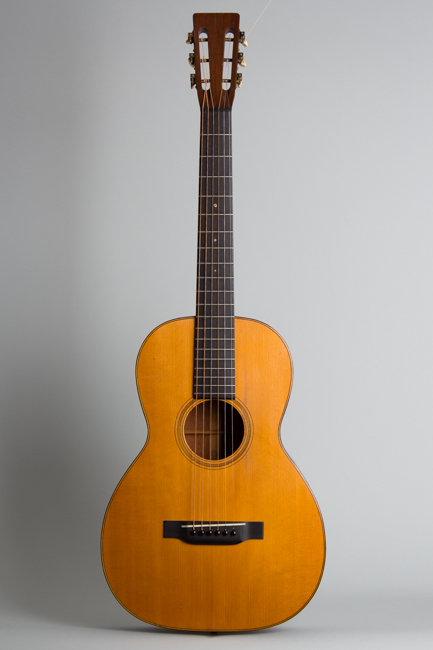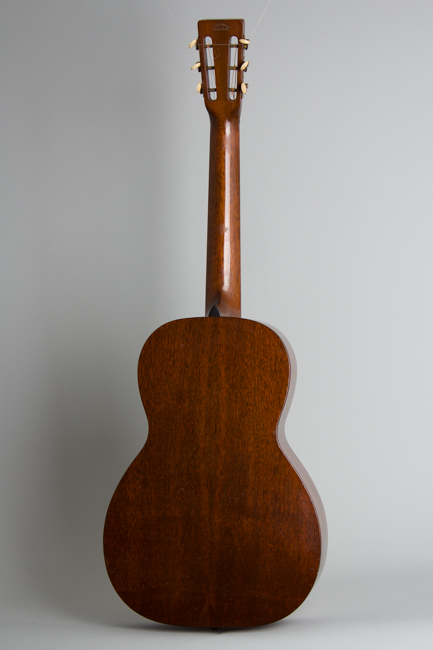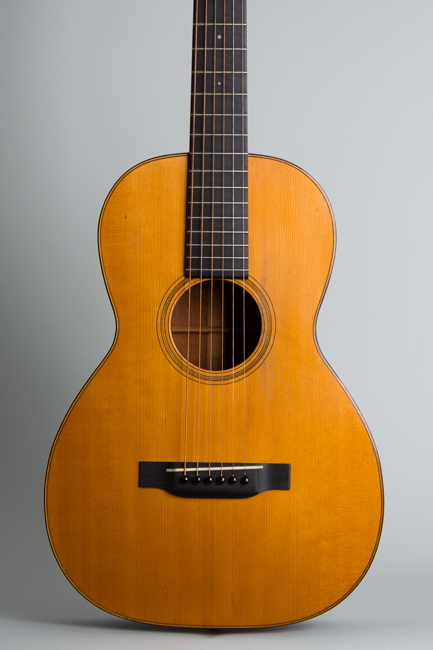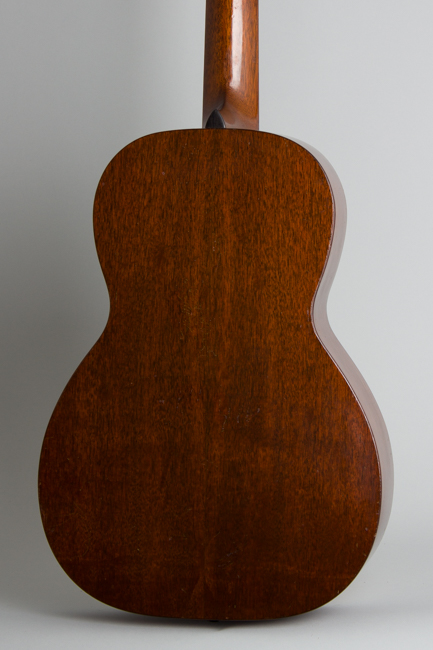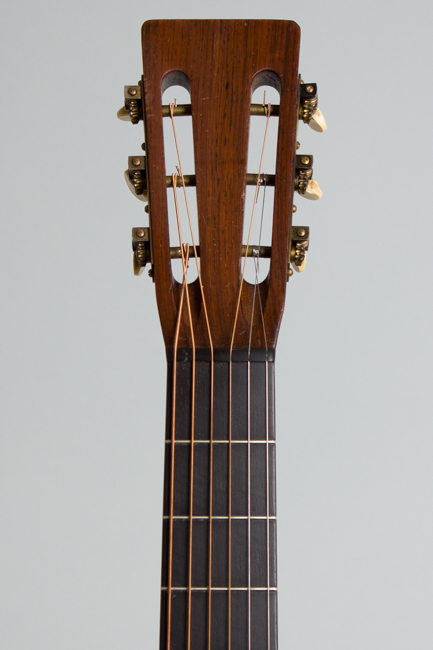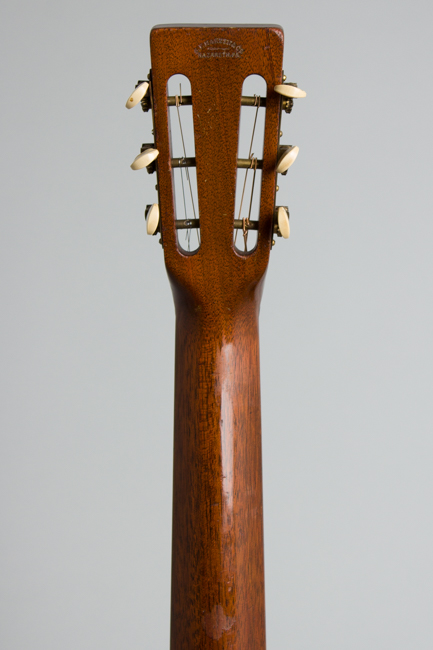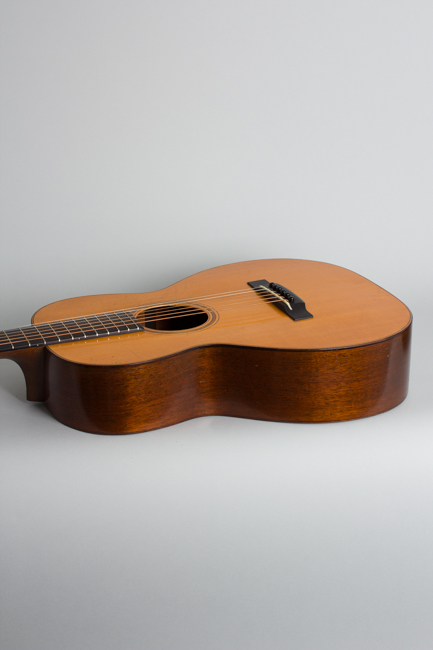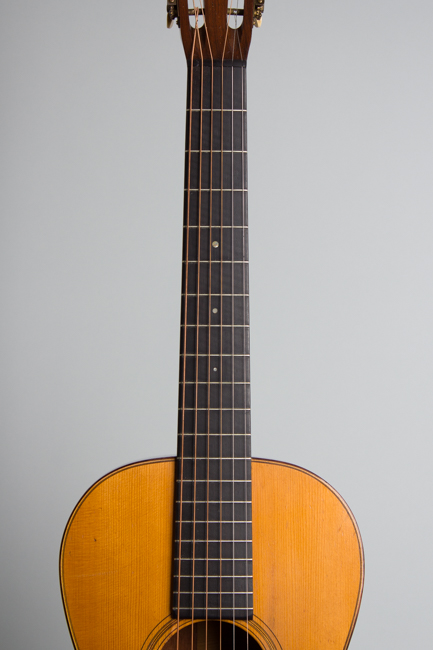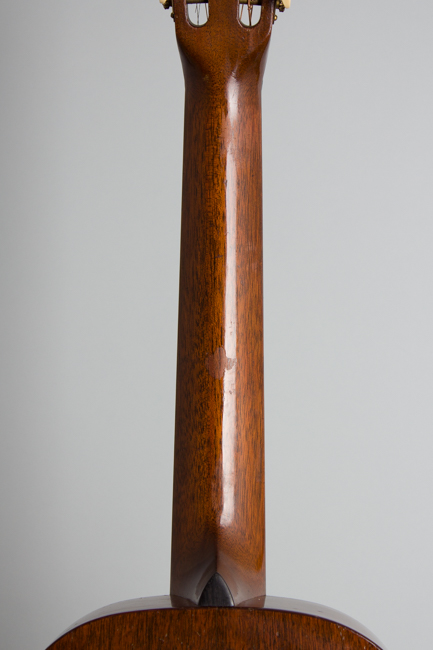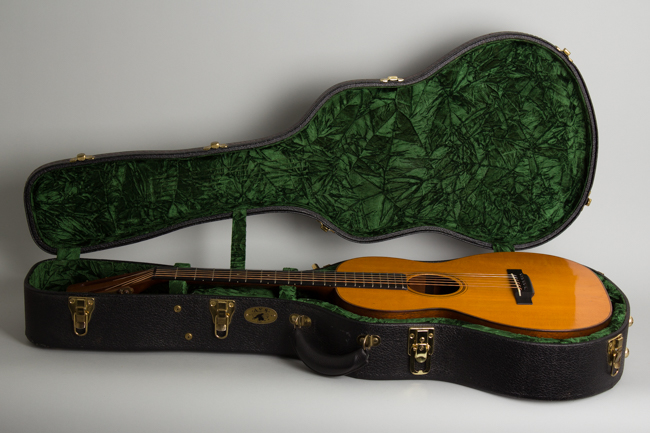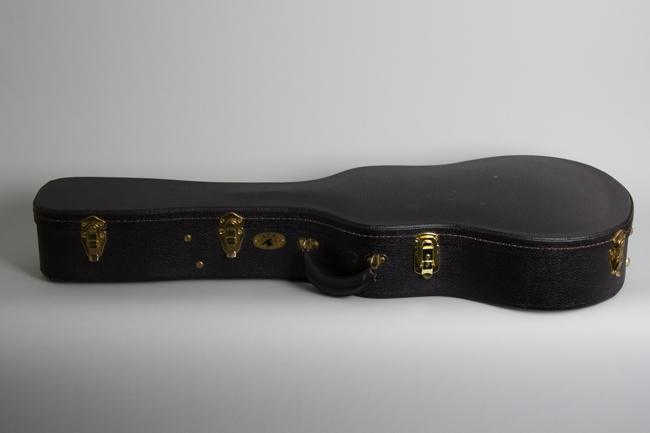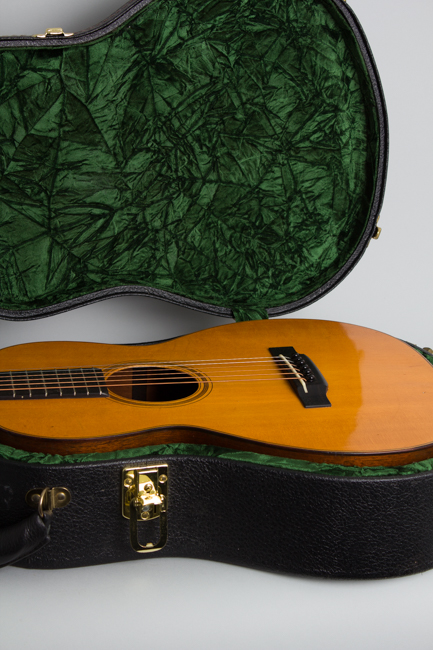C. F. Martin 0-18 Flat Top Acoustic Guitar (1930)
This item has been sold.
Item # 10753
Prices subject to change without notice.
C. F. Martin 0-18 Model Flat Top Acoustic Guitar (1930), made in Nazareth, PA, serial # 41653, natural lacquer finish, Adirondack spruce top, Honduras mahogany sides and neck, ebony fingerboard and bridge, black tolex hard shell case.
This is a lovely example of a Martin 0-18 from what some old-time fans would consider the perfect year. By 1930 the $40.00 0-18 had firmly settled into its specifications as a steel-string guitar, in the 1920sstill a fairly new idea at Martin. This model has *slightly* beefed-up bracing compared to its earlier 1920's ancestors, but by modern standards the scalloped X pattern remains extremely light. The main difference is the addition of the new bottom-belly bridge, which gives a greater gluing area and strengthens that crucial spot on the top without diminishing the tone.
The 0-18 is traditionally a 13 1/2" wide mahogany-bodied, spruce top guitar with plain trim. It would be only built in this 12-fret form for another couple of years before the advent of pickguards and 14-fret neck joints decidedly changed its character as the 1930s went on. This 1930 guitar shows the early evolution of the model, still in its 1920's configuration but better equipped to handle increased steel string tension. The other features remain as before; the top and back are bound with rosewood and the bridge and fingerboard made of very high-grade dark ebony. The position marks are a simple descending-sized pearl dots, the nut is ebony and the tuners are unplated Waverly strips with grained ivoroid buttons.
This small-bodied mahogany guitar may have been near the bottom of the Martin line, but listing at $40 (plus case) was still a more expensive instrument than many 1930-era flat top guitars, and built to the lofty standards that only C.F. Martin & Co. ever sustained. This 0-18 is one of only 283 sold in 1930, the year the depression began to really kick in. The sound is more powerful than one might expect, full bodied with surprising depth for the small body. It makes a great fingerstyle instrument but also works well with a flatpick, appropriate for solo playing, stringband music to early jazz and beyond. This is simply a neat little 12-fret guitar, in this relatively clean and unaltered condition something we don't see as much as we'd like anymore.
Overall length is 38 in. (96.5 cm.), 13 1/2 in. (34.3 cm.) wide at lower bout, and 4 1/8 in. (10.5 cm.) in depth at side, taken at the end block. Scale length is 24 3/4 in. (629 mm.). Width of nut is 1 7/8 in. (48 mm.).
This is a lovely and nicely original guitar, showing some general wear and tear but no major abuse or alterations. The finish shows dings, dents and scrapes but less of the large pickwear areas so often seen on older flat tops. The only spot noticeably worn down into the wood is below the strings from the fingerboard extension through the lip of the soundhole and the area that would be covered with a pickguard on more recent Martins, and even this is shallower than many. There a couple of spots that look like perhaps some very light touchups were added, most notably on the rims on either side of the heel but under blacklight examination the finish is absolutely consistent showing no additional or alteration.
The neck has been neatly reset and the original bar frets are still intact and very playable showing only some very light wear. There is a small impact crack on the treble side at the turn of the lower bout, solidly sealed up but not finished over. The guitar shows no other cracks, which is kind of amazing. Internally it is untouched including the tiny 1920's style bridgeplate, and the bridge does not appear to have ever been reglued. While not pristine this guitar is in well above average condition for a steel-string Martin from this era, and simply a superb playing and sounding instrument. Overall Excellent - Condition.
This is a lovely example of a Martin 0-18 from what some old-time fans would consider the perfect year. By 1930 the $40.00 0-18 had firmly settled into its specifications as a steel-string guitar, in the 1920sstill a fairly new idea at Martin. This model has *slightly* beefed-up bracing compared to its earlier 1920's ancestors, but by modern standards the scalloped X pattern remains extremely light. The main difference is the addition of the new bottom-belly bridge, which gives a greater gluing area and strengthens that crucial spot on the top without diminishing the tone.
The 0-18 is traditionally a 13 1/2" wide mahogany-bodied, spruce top guitar with plain trim. It would be only built in this 12-fret form for another couple of years before the advent of pickguards and 14-fret neck joints decidedly changed its character as the 1930s went on. This 1930 guitar shows the early evolution of the model, still in its 1920's configuration but better equipped to handle increased steel string tension. The other features remain as before; the top and back are bound with rosewood and the bridge and fingerboard made of very high-grade dark ebony. The position marks are a simple descending-sized pearl dots, the nut is ebony and the tuners are unplated Waverly strips with grained ivoroid buttons.
This small-bodied mahogany guitar may have been near the bottom of the Martin line, but listing at $40 (plus case) was still a more expensive instrument than many 1930-era flat top guitars, and built to the lofty standards that only C.F. Martin & Co. ever sustained. This 0-18 is one of only 283 sold in 1930, the year the depression began to really kick in. The sound is more powerful than one might expect, full bodied with surprising depth for the small body. It makes a great fingerstyle instrument but also works well with a flatpick, appropriate for solo playing, stringband music to early jazz and beyond. This is simply a neat little 12-fret guitar, in this relatively clean and unaltered condition something we don't see as much as we'd like anymore.
Overall length is 38 in. (96.5 cm.), 13 1/2 in. (34.3 cm.) wide at lower bout, and 4 1/8 in. (10.5 cm.) in depth at side, taken at the end block. Scale length is 24 3/4 in. (629 mm.). Width of nut is 1 7/8 in. (48 mm.).
This is a lovely and nicely original guitar, showing some general wear and tear but no major abuse or alterations. The finish shows dings, dents and scrapes but less of the large pickwear areas so often seen on older flat tops. The only spot noticeably worn down into the wood is below the strings from the fingerboard extension through the lip of the soundhole and the area that would be covered with a pickguard on more recent Martins, and even this is shallower than many. There a couple of spots that look like perhaps some very light touchups were added, most notably on the rims on either side of the heel but under blacklight examination the finish is absolutely consistent showing no additional or alteration.
The neck has been neatly reset and the original bar frets are still intact and very playable showing only some very light wear. There is a small impact crack on the treble side at the turn of the lower bout, solidly sealed up but not finished over. The guitar shows no other cracks, which is kind of amazing. Internally it is untouched including the tiny 1920's style bridgeplate, and the bridge does not appear to have ever been reglued. While not pristine this guitar is in well above average condition for a steel-string Martin from this era, and simply a superb playing and sounding instrument. Overall Excellent - Condition.
